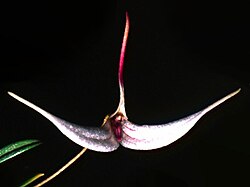| Trisetella | |
|---|---|
 | |
| Trisetella hoeijeri | |
| Scientific classification | |
| Kingdom: | Plantae |
| Clade: | Tracheophytes |
| Clade: | Angiosperms |
| Clade: | Monocots |
| Order: | Asparagales |
| Family: | Orchidaceae |
| Subfamily: | Epidendroideae |
| Subtribe: | Pleurothallidinae |
| Genus: | Trisetella Luer |
| Type species | |
| Trisetella triaristella | |
| Synonyms [1] | |
| |
Trisetella is a genus of orchids, native to Central and South America. Twelve of the 23 currently known species are endemic to Ecuador. [1] [2] They bear small flowers with fused sepals and fused petals. The synsepal bears three hair-like tails, which is the namesake of Trisetella ("three little bristles").
Species accepted as of June 2014: [1]
- Trisetella abbreviata Luer - Ecuador
- Trisetella andreettae Luer - Ecuador
- Trisetella cordeliae Luer - Peru
- Trisetella dalstroemii Luer - Ecuador
- Trisetella didyma (Luer) Luer - Ecuador
- Trisetella dressleri (Luer) Luer - Panama
- Trisetella escobarii Luer - Colombia
- Trisetella fissidens Luer & Hirtz - Ecuador
- Trisetella gemmata (Rchb.f.) Luer - Colombia
- Trisetella hirtzii Luer - Ecuador
- Trisetella hoeijeri Luer & Hirtz - Ecuador
- Trisetella klingeri Luer - Ecuador
- Trisetella lasiochila Pupulin - Costa Rica
- Trisetella nodulifera Luer & Hirtz - Ecuador, Peru
- Trisetella pantex (Luer) Luer - Ecuador
- Trisetella regia Königer - Peru
- Trisetella scobina Luer - Ecuador, Bolivia
- Trisetella sororia Luer & Andreetta - Ecuador
- Trisetella strumosa Luer & Andreetta - Ecuador
- Trisetella tenuissima (C.Schweinf.) Luer - Colombia, Panama
- Trisetella triaristella (Rchb.f.) Luer - Costa Rica, Panama, Colombia, Ecuador, Bolivia
- Trisetella triglochin (Rchb.f.) Luer - Costa Rica, Panama, Colombia, Ecuador, Bolivia, Brazil, Venezuela, the Guianas
- Trisetella vittata (Luer) Luer - Ecuador